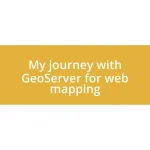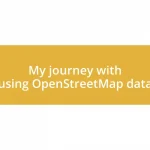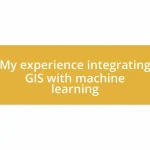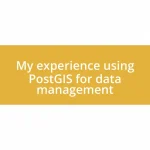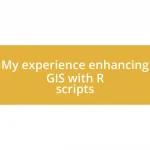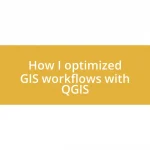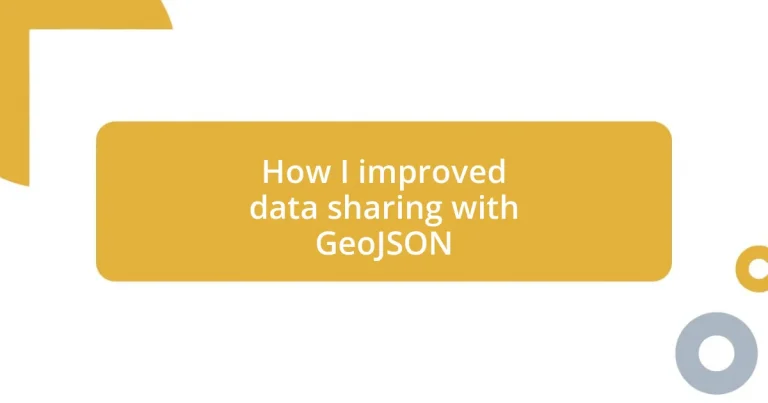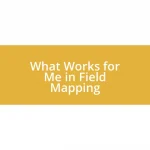Key takeaways:
- GeoJSON is an intuitive and elegant format for sharing geographic data, allowing seamless integration of geospatial elements and associated properties.
- Best practices for GeoJSON usage include keeping files lean, using consistent naming conventions, and validating files before sharing to enhance performance and usability.
- Utilizing effective editing tools (like GeoJSON.io and QGIS) and establishing clear communication and version control can significantly improve collaboration and data management.
- Leveraging existing libraries for API integration and providing clear documentation can streamline the implementation of GeoJSON and enhance user satisfaction.
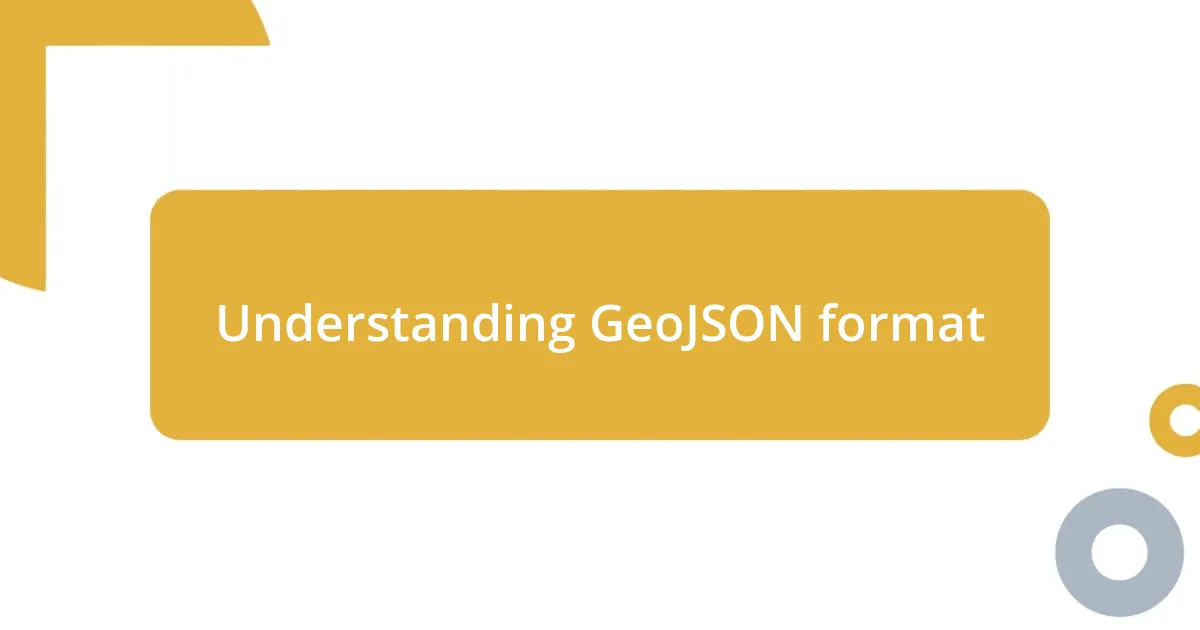
Understanding GeoJSON format
When I first encountered GeoJSON, I was surprised by its elegance. It’s a format based on JSON (JavaScript Object Notation) that simplifies the sharing of geographic data. This simplicity allows developers to easily integrate geographical elements, leaving me wondering why it took so long for the format to gain traction.
GeoJSON structures its data in a way that’s intuitive. It includes various types of geometries, such as points, lines, and polygons, each defined through coordinates. I remember the first time I visualized my data using these geometries; it felt like I was unveiling a new dimension to my work. Isn’t it fascinating how a set of coordinates can transform into vibrant maps?
Diving deeper, I found that GeoJSON’s ability to hold complex data like properties alongside geometries is crucial for effective data analysis. This feature means I can combine location with other important information seamlessly. It’s almost magical how I can represent intricate ecosystems or urban layouts with such clarity; it gets me excited about the possibilities of data sharing in geospatial contexts.
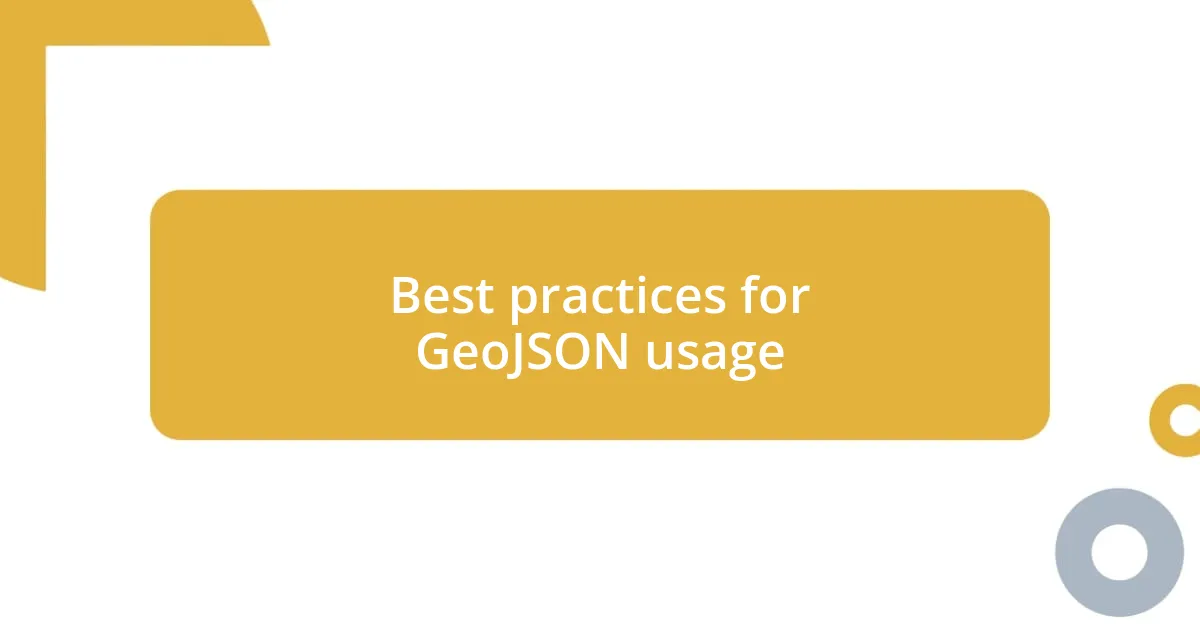
Best practices for GeoJSON usage
Understanding the best practices for GeoJSON usage can significantly enhance your data sharing experience. One key point I’ve learned is to keep your GeoJSON files lean. When I first started using GeoJSON, I packed in as much detail as possible, thinking more data equaled more value. However, I quickly realized that bloated files could affect performance and loading times, especially in web applications. Keeping your data concise makes it easier to work with while ensuring users get quick responses.
Another practice I swear by is using consistent naming conventions for properties. The first time I shared a GeoJSON file with colleagues, I didn’t standardize my property names, which led to confusion. Some users were unsure whether “city_name” referred to the actual city or a feature within the geographic context. By maintaining a clear and uniform system, you can foster clarity and usability.
Finally, validating your GeoJSON before deployment is crucial. I recall a project where I rushed to share my data without proper validation checks. As a result, I encountered frustrating errors that delayed the project. Taking the time to use tools like GeoJSONLint has become a routine step in my workflow, helping me catch issues early on. This simple practice empowers me with confidence in the data I share, streamlining collaboration and enhancing productivity.
| Best Practices | Details |
|---|---|
| Keep Files Lean | Avoid bloated data to improve performance and loading speed. |
| Use Consistent Naming | Establish a standard for property names to avoid confusion. |
| Validate GeoJSON | Use tools for validation to catch errors before sharing. |
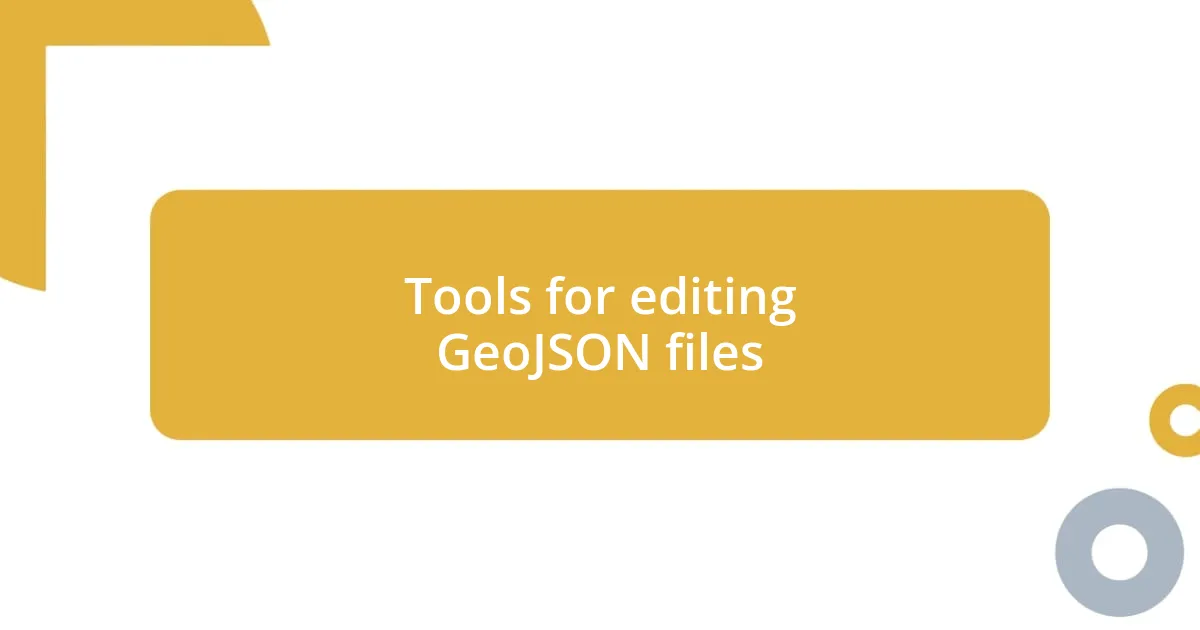
Tools for editing GeoJSON files
When it comes to editing GeoJSON files, there’s a wealth of tools available that make the process straightforward and efficient. I remember my early struggles with raw text editors; it felt like trying to navigate a maze without a map. Fortunately, there are now user-friendly platforms that cater specifically to GeoJSON data, allowing me to visualize changes in real-time and ensuring that my edits are not only accurate but also intuitive.
Here are some of the tools that I’ve found particularly helpful for editing GeoJSON files:
- GeoJSON.io: A web-based tool that lets you draw and edit features on a map, providing immediate feedback on your changes.
- QGIS: A powerful open-source geographic information system that allows for complex data manipulation and visualization.
- Mapshaper: An online tool for simplifying and refining GeoJSON files, which helped me reduce file size drastically without losing essential data.
- VSCode with GeoJSON extensions: I love using Visual Studio Code with specific plugins for GeoJSON, providing syntax highlighting and formatting that makes it easy to spot errors.
I still fondly recall how transformative it was to use platforms like GeoJSON.io during a collaborative project. The real-time editing capability allowed my team and me to brainstorm spatial ideas together, enhancing our communication and workflow. Each edit felt like a puzzle piece falling into place, contributing not just to the project’s progress, but also fostering a cooperative spirit among all of us involved.
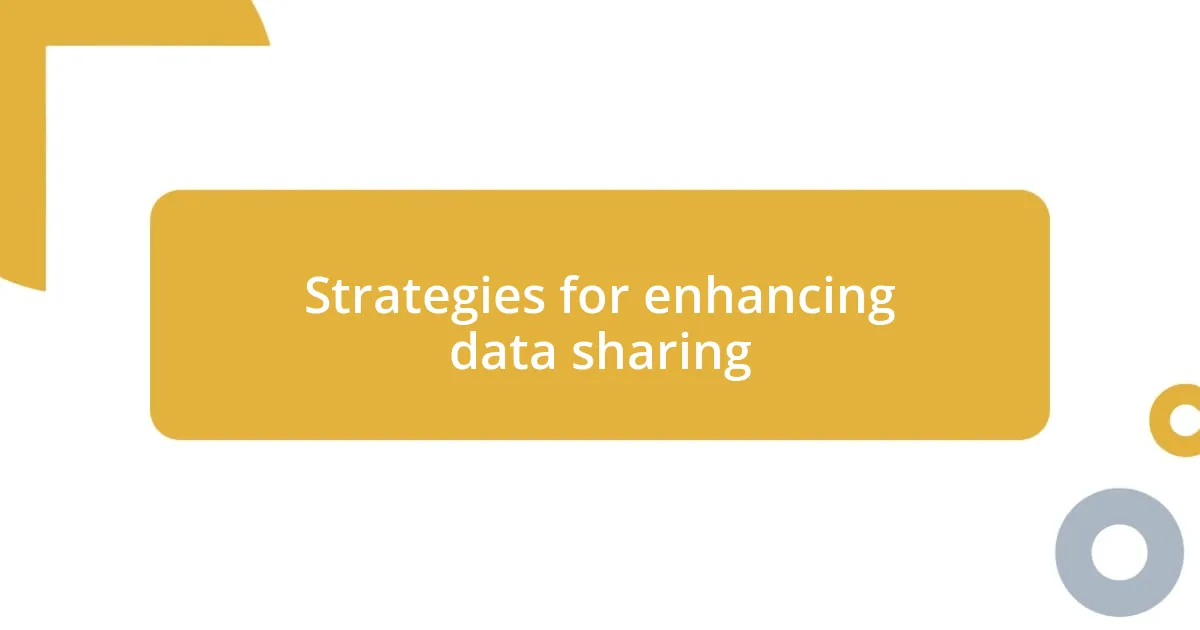
Strategies for enhancing data sharing
One effective strategy I’ve found for enhancing data sharing is establishing clear communication guidelines among team members. During one of my early GeoJSON projects, I assumed everyone was on the same page regarding data structure, and that led to some frustrating misunderstandings. I learned the hard way that holding a quick kickoff meeting to discuss data formatting and expectations can save hours of backtracking later on. Have you ever faced a similar situation where a lack of clarity hindered collaboration? Being proactive in discussions sets a positive tone and ensures everyone’s aligned right from the start.
Another valuable approach is to embrace version control for your GeoJSON files. I vividly recall a project where I made significant changes to the data only to realize later that I needed to revert to an older version. It felt like spinning my wheels! Implementing a version control system, like Git, has been a game-changer for me. Not only does it keep a history of changes, but it also allows my teammates to view and understand the evolution of the data. This practice not only boosts confidence but fosters collaboration, as everyone can contribute and adapt without the fear of causing chaos.
Lastly, integrating visualizations directly into your sharing workflow can dramatically improve the way users interact with your GeoJSON data. When I started incorporating simple visual aids, like maps demonstrating data layers, I noticed engagement skyrocketed. It dawned on me that people often grasp concepts better through visuals than numbers alone. Consider this: wouldn’t it be more intuitive to present information visually, allowing users to understand spatial relationships and patterns? I’ve seen firsthand how these visual representations can spark conversations and lead to insightful discussions that enhance overall data comprehension.
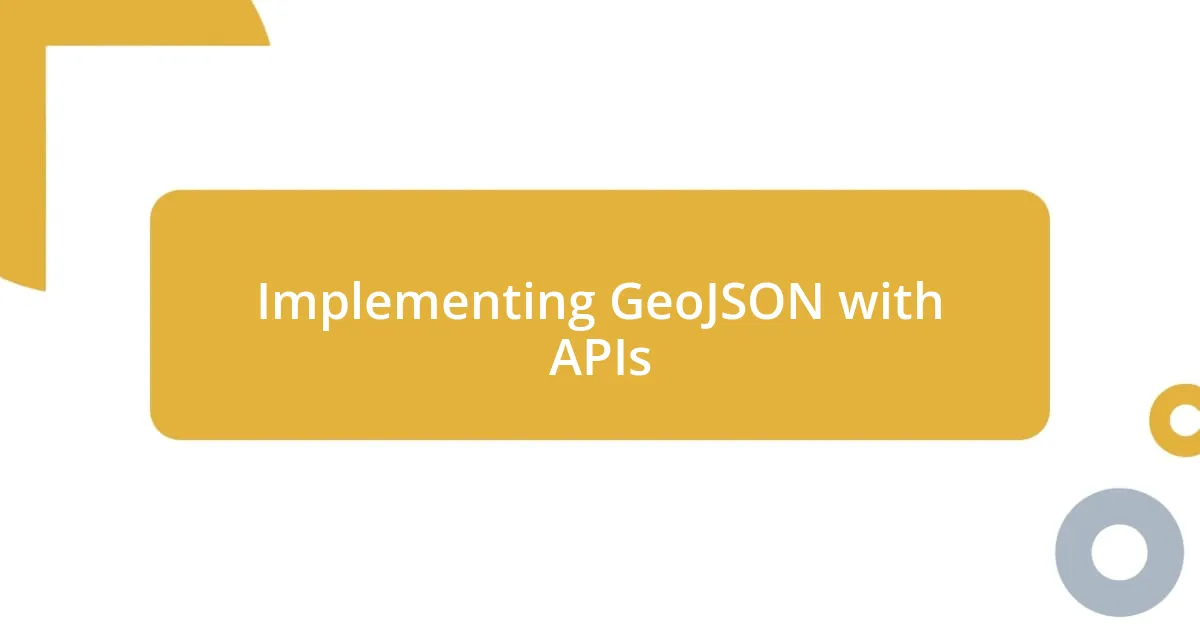
Implementing GeoJSON with APIs
When implementing GeoJSON with APIs, I’ve found that leveraging existing libraries can simplify the integration process. For instance, using libraries like Leaflet or Mapbox has allowed me to seamlessly visualize GeoJSON data on interactive maps. Have you ever spent hours trying to render your geographical data only to see a blank screen? I definitely have, and using these libraries felt like flipping a magic switch; everything just clicked into place, transforming what used to be tedious into a streamlined workflow.
Another significant aspect is ensuring that your API is designed to handle GeoJSON effectively. In one particular project, I faced challenges when my API didn’t accept GeoJSON formats correctly. I remember the frustration of troubleshooting the endpoints, which seemed straightforward at first. What turned the tide was implementing proper content negotiation in the API, allowing clients to specify how they wanted their data formatted. This change not only reduced errors but also increased user satisfaction, as developers could now receive GeoJSON responses that met their specifications effortlessly.
I also recommend documenting the API with detailed examples of how to consume GeoJSON data. I’ve seen firsthand how clear documentation can be a game-changer. During a hackathon where my team was building an application using shared GeoJSON endpoints, the lack of clear examples initially slowed us down. Once we created straightforward usage instructions—complete with sample requests and responses—the momentum picked up. It’s incredible how a bit of clarity can spark creativity and problem-solving, isn’t it?



